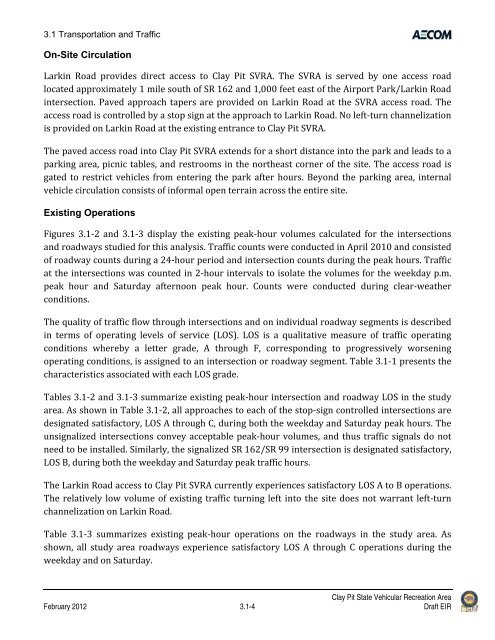Draft Environmental Impact Report - California Off Highway Vehicle ...
Draft Environmental Impact Report - California Off Highway Vehicle ...
Draft Environmental Impact Report - California Off Highway Vehicle ...
You also want an ePaper? Increase the reach of your titles
YUMPU automatically turns print PDFs into web optimized ePapers that Google loves.
3.1 Transportation and Traffic<br />
On-Site Circulation<br />
Larkin Road provides direct access to Clay Pit SVRA. The SVRA is served by one access road<br />
located approximately 1 mile south of SR 162 and 1,000 feet east of the Airport Park/Larkin Road<br />
intersection. Paved approach tapers are provided on Larkin Road at the SVRA access road. The<br />
access road is controlled by a stop sign at the approach to Larkin Road. No left‐turn channelization<br />
is provided on Larkin Road at the existing entrance to Clay Pit SVRA.<br />
The paved access road into Clay Pit SVRA extends for a short distance into the park and leads to a<br />
parking area, picnic tables, and restrooms in the northeast corner of the site. The access road is<br />
gated to restrict vehicles from entering the park after hours. Beyond the parking area, internal<br />
vehicle circulation consists of informal open terrain across the entire site.<br />
Existing Operations<br />
Figures 3.1‐2 and 3.1‐3 display the existing peak‐hour volumes calculated for the intersections<br />
and roadways studied for this analysis. Traffic counts were conducted in April 2010 and consisted<br />
of roadway counts during a 24‐hour period and intersection counts during the peak hours. Traffic<br />
at the intersections was counted in 2‐hour intervals to isolate the volumes for the weekday p.m.<br />
peak hour and Saturday afternoon peak hour. Counts were conducted during clear‐weather<br />
conditions.<br />
The quality of traffic flow through intersections and on individual roadway segments is described<br />
in terms of operating levels of service (LOS). LOS is a qualitative measure of traffic operating<br />
conditions whereby a letter grade, A through F, corresponding to progressively worsening<br />
operating conditions, is assigned to an intersection or roadway segment. Table 3.1‐1 presents the<br />
characteristics associated with each LOS grade.<br />
Tables 3.1‐2 and 3.1‐3 summarize existing peak‐hour intersection and roadway LOS in the study<br />
area. As shown in Table 3.1‐2, all approaches to each of the stop‐sign controlled intersections are<br />
designated satisfactory, LOS A through C, during both the weekday and Saturday peak hours. The<br />
unsignalized intersections convey acceptable peak‐hour volumes, and thus traffic signals do not<br />
need to be installed. Similarly, the signalized SR 162/SR 99 intersection is designated satisfactory,<br />
LOS B, during both the weekday and Saturday peak traffic hours.<br />
The Larkin Road access to Clay Pit SVRA currently experiences satisfactory LOS A to B operations.<br />
The relatively low volume of existing traffic turning left into the site does not warrant left‐turn<br />
channelization on Larkin Road.<br />
Table 3.1‐3 summarizes existing peak‐hour operations on the roadways in the study area. As<br />
shown, all study area roadways experience satisfactory LOS A through C operations during the<br />
weekday and on Saturday.<br />
Clay Pit State Vehicular Recreation Area<br />
February 2012 3.1-4 <strong>Draft</strong> EIR








